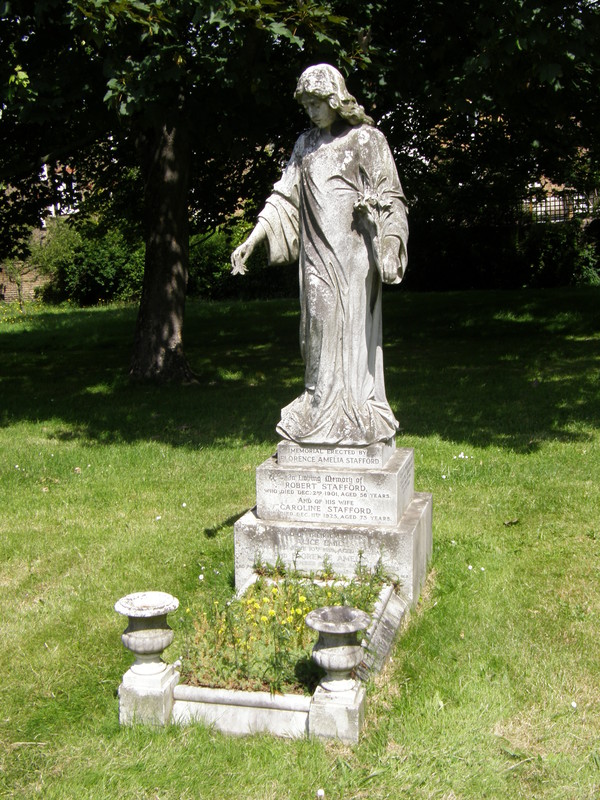
Things started off on the wrong foot this morning, and I have to admit it spoiled things for a little while. As I lined up to take a shot of Turnham Green station – more to make a note of my starting time than anything else, as I already have a shot of the station from yesterday's walk – a man, who was unloading flowers from a white van, walked up to me and said in a fairly brusque manner, 'Oy, why are you taking pictures of the Tube?'
'Well,' I said, putting on my best smile. 'I'm walking the Tube for charity and taking photos of all the stations as I go, to prove I've been there.'
He didn't react at all, which wrong-footed me slightly, as most people break into a smile when they hear what I'm doing, and wish me luck. Indeed, he kept staring at me, as if this was no explanation at all.
'Um,' I said. 'I'm heading off to Stamford Brook now, along the District line,' hoping that this would do the trick. Instead, he just looked at me as if I was something unwelcome he'd picked up on the sole of his shoe, and went back to unloading his flowers. I wondered if I'd done something to offend him – having long dark hair and a beard, perhaps, with the Middle Eastern suntan of someone who's been walking for three weeks in the summer sun – but then I realised he was driving a white van, and figured I'd better head off before he decided I was a terrorist and tried to lock me up for 42 days without charge.
Turnham Green to Stamford Brook

It particularly annoyed me that I should get the cold shoulder from the locals at Turnham Green station, as I lived here for three years and still consider it a kind of home. Feeling a little rejected, I slumped east from the station along Bath Road, but it wasn't long before the pretty houses of Chiswick started to cheer me up. Separated from the busy main road by the Tube line, this is a landscape of desirable detached and semi-detached houses, with the odd bit of greenery thrown in for good measure.
Stamford Brook station dates from and is tucked away to the south of the railway bridge. It's a notable station for one reason: back on , this was the first station to have an automatic ticket barrier installed. Automatic ticket issuing was introduced in the 1920s, but it took another 40 years before London Underground could dispense with human inspectors at the other end. Just imagine what all those early employees would think of the Oyster card system...
Stamford Brook to Ravenscourt Park
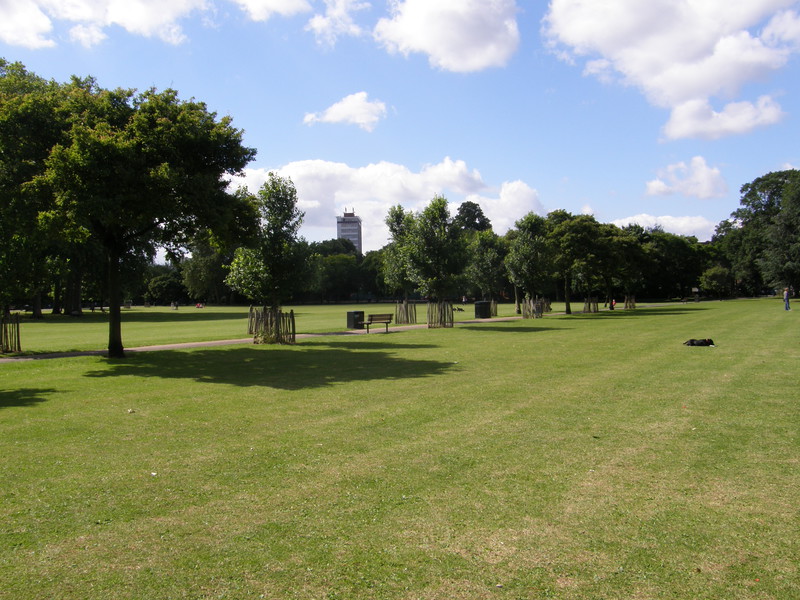
From Stamford Brook the houses get even more delightful as you approach the 32-acre Ravenscourt Park, a large, airy park that consists of a wide open grassy area in the southern half, and a manicured garden to the north. A popular spot with the pram-pushing inhabitants of Nappy Valley, it's an enjoyable place to relax when the sun is out. The park was originally the gardens of Ravenscourt House, which was built in 1650 but was destroyed in 1941 by incendiary bombs during the Blitz; the only remaining building is the stable block, which houses a pleasant café in the middle of the park.
Ravenscourt Park station is just off the southeast corner of the park, on the other side of the railway bridge. The station was originally opened on the London and South Western Railway line to Richmond on , though it was originally called Shaftesbury Road, and on the Metropolitan District Railway (now the District line) extended its lines from Hammersmith to just east of the station, thus linking this part of the world into what we now know as the Underground. The station is reasonably large, with the red brick ticket hall extending quite a way down Ravenscourt Place, opposite some lovely houses.
Ravenscourt Park to Hammersmith
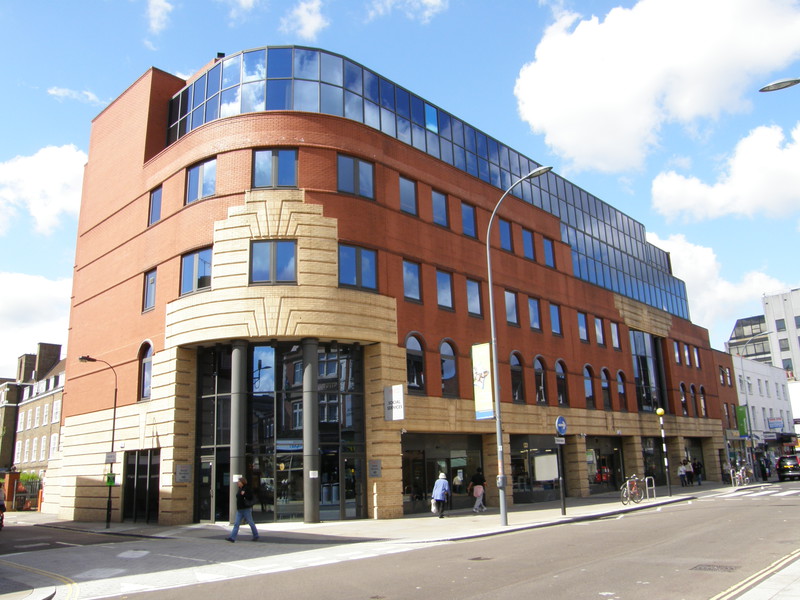
From Ravenscourt Park I thought I'd join King Street, the main shopping road in Hammersmith, just to set the tone for the next couple of stations. King Street is a busy shopping street that stretches all the way from Chiswick to Hammersmith, and walking along the main road is an interesting exercise in seeing the cappuccino cafés of Chiswick slowly morph into the Primarks and Prets of Hammersmith. It is much more pleasant away from the main road (like everywhere in the city), but a quick burst of King Street is good for the soul, if only to compare the Chicken Cottages and curry houses with the delicious architecture to be found in the backstreets.
Hammersmith station (which is a separate entity from the Hammersmith & City line's station of the same name) continues the theme by being buried deep in a huge shopping centre. The original station buildings were demolished in the early 1990s and were rebuilt as part of the Broadway Centre, which combines the Tube station, a bus station, a shopping centre and office space (the latter housing the headquarters of Coca-Cola Great Britain Ltd). If you aren't here for the shopping, though, this isn't a particularly exciting place to linger, though the shops are a convenient place to stock up with refreshments, should you fancy a break.
Hammersmith to Barons Court
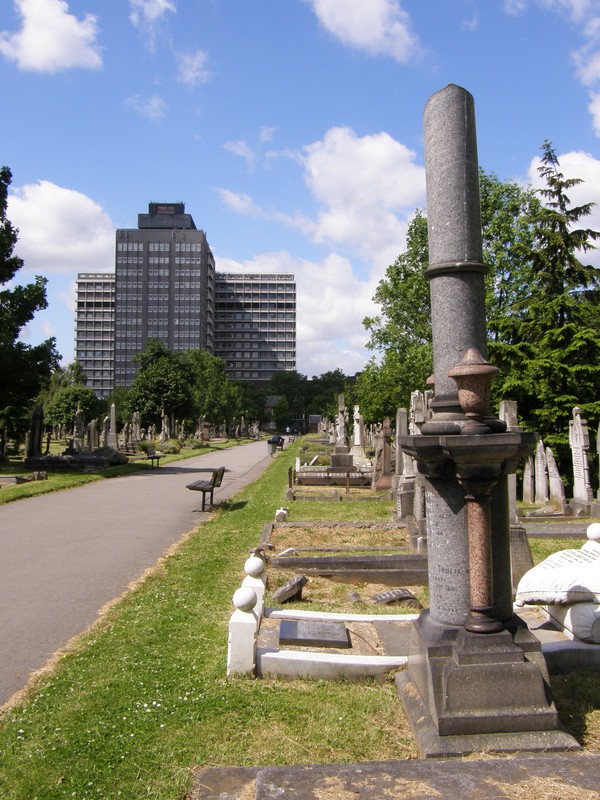
Easily the most famous Hammersmith landmark (for me, anyway) is the Hammersmith Apollo, just south of the shopping centre. Dating from 1932 and designed in an Art Deco style, it was known as the Hammersmith Odeon from 1962 to 1963, and during this, its heyday, it hosted all sorts of famous artists, including the Beatles, Queen, Bob Marley and Neil Young. But the most famous event took place in , when David Bowie played his last show as Ziggy Stardust, famously announcing the break-up of the Spiders from Mars before the last number, much to the surprise of the band, who had no idea their careers as Bowie's backing band were over.
Down Fulham Palace Road from the busy Hammersmith flyover is Charing Cross Hospital. The name comes from the fact that the hospital was originally located near Charing Cross, but in 1973 a new building was opened in Hammersmith, and the hospital moved, taking its name with it. It's an impending building, dominating the skyline, but the best views can be had from Hammersmith Cemetery around the back of the hospital, a quiet place away from the traffic chaos of Hammersmith. Indeed, when I wandered through the graves in the patchy sun of an English summer, I stumbled across a woman sunbathing in a skimpy, bright orange Brazilian bikini, right there among the graves; I'm sure the local residents appreciated her company, albeit silently.
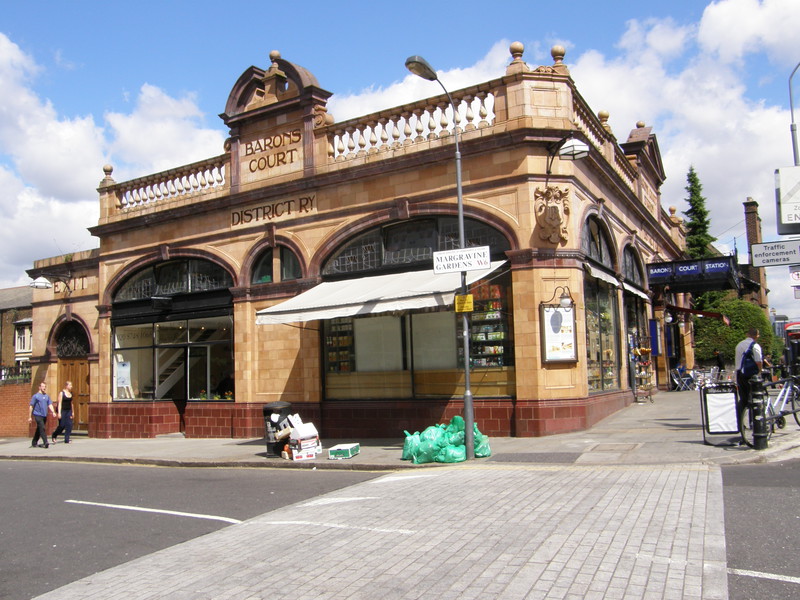
Barons Court station is a Grade II listed building, and it's easy to see why. Opened on and designed by Harry Ford (who also designed the Earls Court Road entrance to Earl's Court station, a couple of stops down the line), the station opening lagged somewhat behind the opening of the line, which dates from 1874. Back then this whole area was rural and was mainly made up of open fields and market gardens, so there was no need for a station in this area, but when the housing boom kicked in during the late Victorian period, a new station was opened to serve the District line. The timing was chosen well, as it was also built to serve the new Piccadilly line that opened slightly later on .
Barons Court to West Kensington

A short stroll from the station, along a road of large, three-storey Victorian terraces, lies Queen's Club. There was a hive of dismantling activity as I walked past, the club having hosted the traditional pre-Wimbledon tennis tournament just last week (incidentally, Rafael Nadal won, and became the first Spaniard to win on grass in 36 years).
The impressive Victorian terraces continue along Baron's Court Road (yes, the road has an apostrophe but the Tube station doesn't, a bizarre situation that is reversed for Earl's Court station in Earls Court), but all pretence at quiet suburbia goes out of the window at the junction of North End Road and Talgarth Road, which manages to redefine the concept of traffic chaos. I should know, because back in 1995, I spent nine happy months living in a room on the top floor of the Famous Three Kings pub (which was known back then as the plain old Three Kings). My mate Lawrence was the assistant manager, and I was looking for somewhere to live in London, so he said I could stay in the spare room in his top-floor flat, rent free, if I gave it a lick of paint, bought some furniture and did a couple of nights behind the bar every week. Not being stupid, I snapped up the offer and moved in straight away. The fact that I worked from home three days a week and had no rent to pay meant that we drank rather more than we should have done, and many was the late night that we'd pop out to the dodgy chicken shack over the road, or to the 24-hour corner shop on the other side of the junction. And all the time the traffic rumbled below, a seemingly constant drone of horns, over-accelerated motorbikes and chuntering trucks.
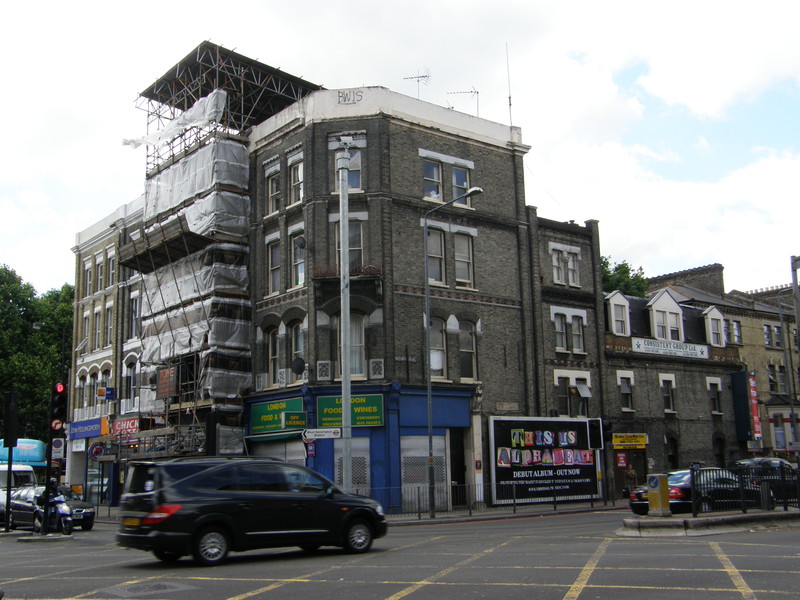
Opposite the pub, and currently shrouded in scaffolding, lives a grimy block of flats that were used as the filming location for Renton's London flat in Trainspotting. The irony isn't lost on me, as the Three Kings was known as a bit of a drug den (at least until Lawrence and his parents, who were the managers, came in and cleaned it up), and a number of the dealers lived in the block over the road. I can remember one of them vividly, as he would often come into the pub, happily tripping away at the bar and causing no problems at all; you learn a thing or two, doing the graveyard shift in a pub like the Three Kings. These days, the renamed and refurbished Famous Three Kings is a completely different venue, and the flats opposite are being renovated; still, at least I'll be able to bore my grandchildren with stories of when everything round here was drug dealers and junk food shops...
West Kensington station sits next to the pub, its Charles Holden-designed frontage dating from 1927 (though the station was originally opened in 1874 as 'Fulham – North End' and was renamed as West Kensington in 1877). It's not the greatest piece of Holden architecture, though, and is rather dwarfed by the Famous Three Kings' impressive glass entrance, right next door, not to mention the constant queue of vans, buses and trucks outside.
West Kensington to Earl's Court
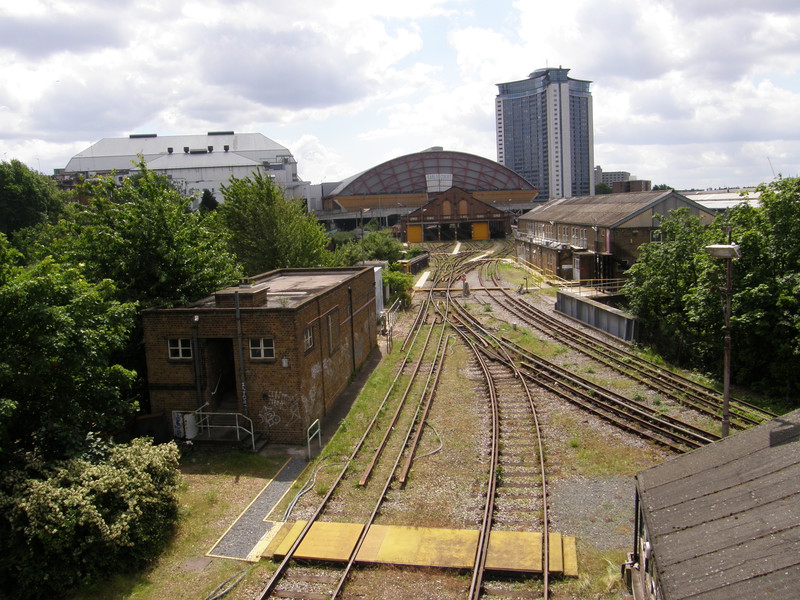
The only sensible way to get from West Kensington to Earl's Court is to brave the A4 (or West Cromwell Road, as it's known round here). If you can zone out the traffic and try not to breathe too deeply, it's an interesting walk over a raised road that crosses the rail tracks that feed Earl's Court to the south. Not only are there two Tube lines passing through here – the District and Piccadilly – but this is also London Overground territory, with the line heading south through West Brompton and on to Clapham Junction. It makes for an impressive view.
Respite is swift, though, because as soon as you turn off the road and into the crescent of Philbeach Gardens, the thick-set terraces reduce the screaming of the traffic to a gentle background rumble. Tucked away in the northwest corner of the crescent are two interesting buildings – the ultra-modern Adshel Centre, and the imposing, red brick, Gothic architecture of St Cuthbert's Church – and the crescent itself is shaded, leafy and an oasis, given its close proximity to Earl's Court. It's also home to the Philbeach Hotel, one of London's longest-running gay hotels, dating from the days when Earls Court was the gay capital of London (and Soho was still dominated by grubby prostitution, rather than chic gay bars).
Earl's Court station is a stone's throw from the end of the crescent, the Warwick Road entrance sitting opposite the huge entrance to Earl's Court Exhibition Centre. Rebuilt between 1936 and 1937, the western entrance to the station looks a bit like a squat version of the top of the BT Tower, with a circular glass tower sitting over the curved entrance. It's interesting, at least.
Earl's Court to Kensington (Olympia)
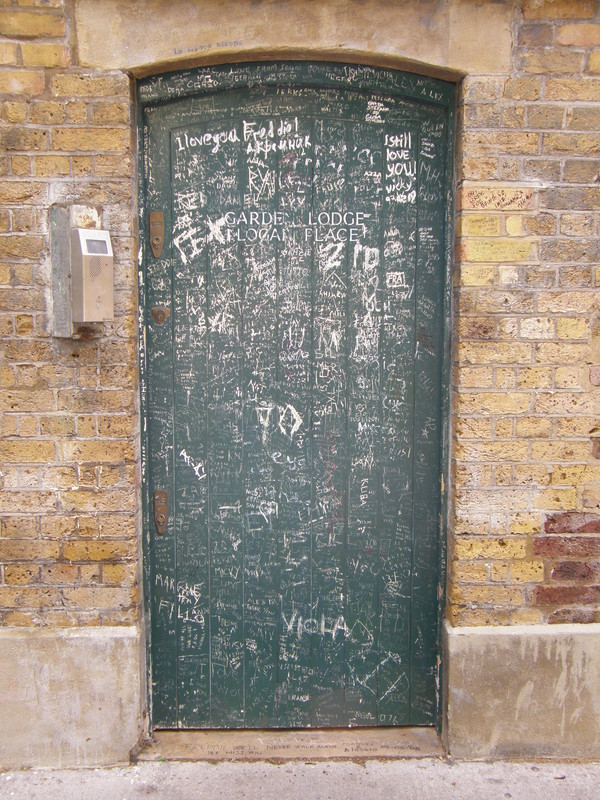
The spur line from Earl's Court to Kensington (Olympia) was originally built as part of the Outer Circle, some of which has now morphed into the London Overground joining West Brompton to Kensington (Olympia) and Willesden Junction, and some of which is now the District line spur from Earl's Court. Although it's a short Tube journey that is mainly aimed at those attending exhibitions at Olympia, it makes for a lovely tubewalk, once you get out of Earls Court, anyway.
Heading north up Earls Court Road, you pass the Earls Court Tavern and soon reach the wide avenue of the A4. Cross over, and suddenly things start to look up, as we're moving into Kensington, one of London's most exclusive suburbs. The best clue can be found down Logan Place, where at the end of the road, past some pretty mews, is a wooden door, painted green, marked 'Garden Lodge, Logan Place'. This is the last home of Freddie Mercury, and the door is smothered with messages from fans, carved into the paint-work. 'I still love you!' cries one, while another says, 'Freddie, we'll never walk alone; we miss you.' It's enough to bring a tear to the eye; Peta and I were talking the other night about which pop star we'd bring back from the dead if we had the power, and Freddie Mercury was pretty high up on the list. Yep, we miss you, Freddie...
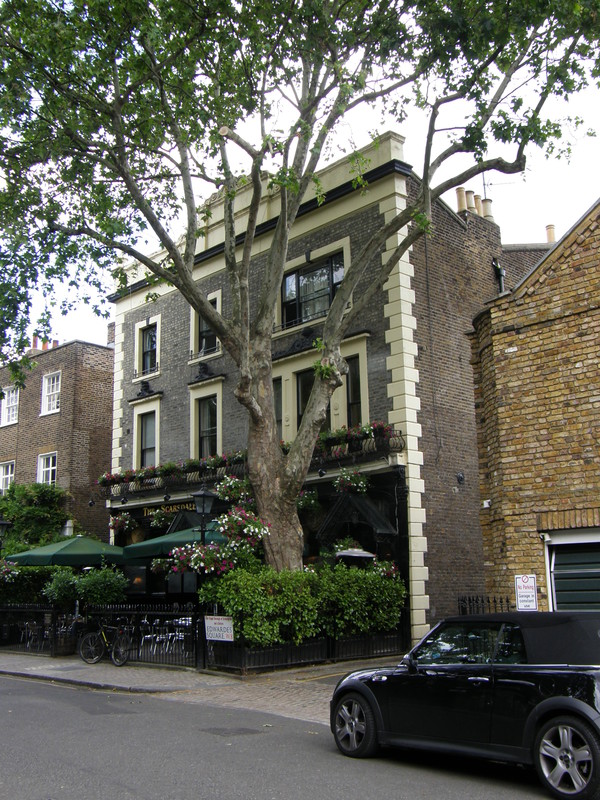
Turning back along Pembroke Road and up Pembroke Villas, prepare to be impressed, because this corner of London is exquisite. The houses of Pembroke Square are lovely, but even they pale into insignificance compared to the beauty of Edwardes Square. The Scarsdale pub on the way into the square is wonderful, and the buildings surrounding the square, which was built between 1811 and 1820 as part of the Holland House Estate, are very pleasant. It's the garden in the middle of the square that is the real treat, though as it's a private garden, all you can do is peek inside. That is, unless you don't realise it's private, as I didn't, and someone has left the gate open, in which case you can pop your head in, scour the scene for signs saying that this is private property (which they don't appear to have), and nip in for a nosey round. I was happily enjoying my visit, but when I tried to exit at the other side of the garden, I discovered that all the other gates were locked, and the penny dropped that this was probably not a public garden after all. Worried that I might be apprehended for trespassing, what with me and my long hair, I made my escape quickly, smiling at the slightly bemused gardener on my way out in silent appreciation at his handiwork. I believe Edwardes Square is open once a year during the Open Garden Squares Weekend, and it's well worth a visit.
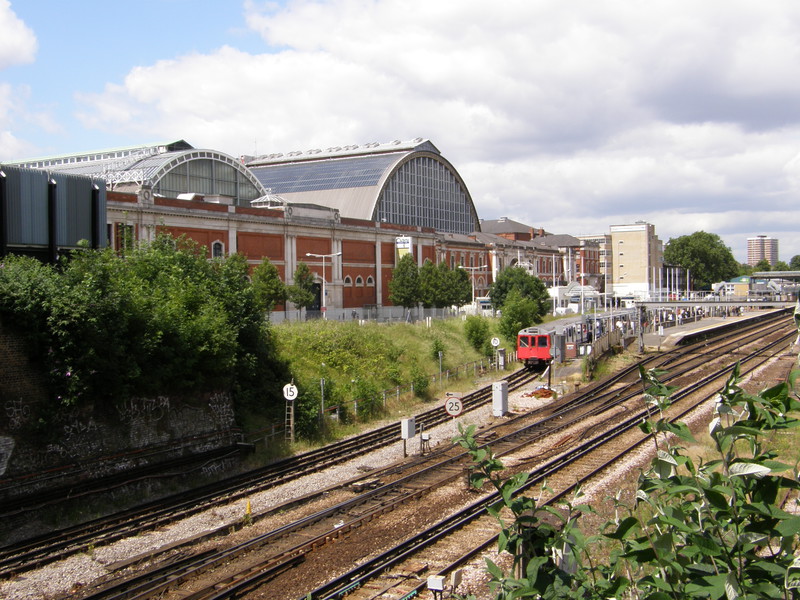
Unfortunately Kensington High Street is a bit of a shock after the peace of Edwardes Square, but the buildings are still impressive, particularly along Warwick Gardens. Possibly the most impressive building is the Inland Revenue office at Charles House, not because it's terribly beautiful, but because it looks exactly how you'd imagine an Inland Revenue office to look. It's just a stone's throw from the bridge over the railway line, where Kensington (Olympia) station sits, tucked away to the side of the Olympia Exhibition Centre. Olympia dates from 1886, and the Grand Hall, which covers some 450 ft by 250 ft, was said at the time to be the largest building in the kingdom to be covered by just one span of iron and glass. It's still an impressive sight today.
Earl's Court to Gloucester Road
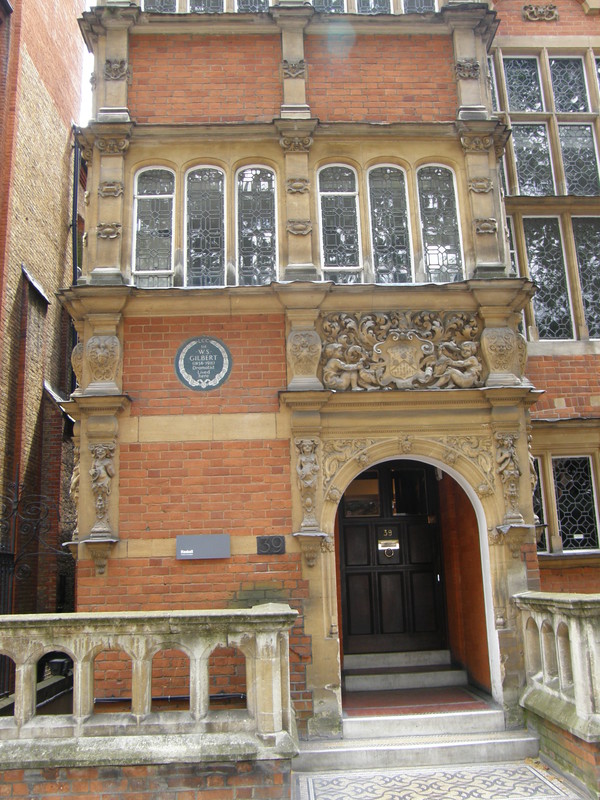
Back at Earl's Court, it's a continuing architectural treat as you walk along Barkston Gardens from the eastern station exit (this exit is pretty similar in appearance to Barons Court station, which is no coincidence as they were both designed by Harry Ford, this one a little later, in 1915). You stumble across the likes of St Jude's Church in Courtfield Gardens (which seems to fill up the entire square), long crescents of five-storey Victorian terraces, and the impressive house of the lyricist WS Gilbert at 39 Harrington Gardens.
Gloucester Road station is again a bit of a shock, as with most of the stations along the District, it is on a busy road junction. This is because the District line was built using the cut-and-cover technique, in which roads were dug out, the railway dropped in, and the road covered over; this means that the line follows the road, and so do the stations. While I was snapping the station, waiting for a break in the traffic so I could get a clear shot, a Chelsea tractor containing uniformed police pulled up and looked knowingly in my direction, but after my first run-in with the police, I knew exactly what to do.
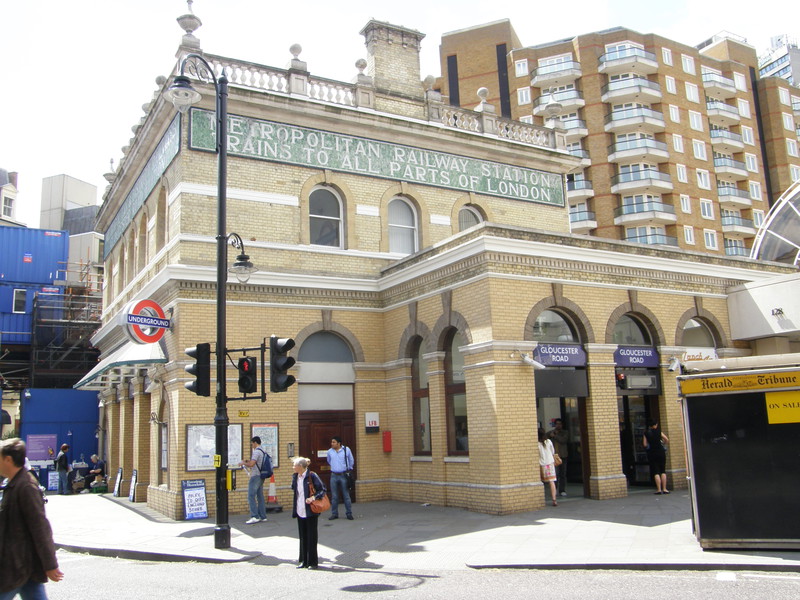
'I suppose you want to know why I'm taking photos of the Tube station,' I said as I wandered up to the window. 'You're not the first policemen to ask me.'
'Um, yeah,' said the officer in the passenger seat, possibly not used to such earnest co-operation from a hippy.
'I'm walking the London Underground for charity,' I said, waving my printed route map in his face. 'And I'm taking a photo of each station to prove I've been there.'
'Ah, OK,' said the driver, beaming at me. 'Well, that's fine, then – good luck with that.'
'Thanks,' I said, and turned back to the Tube station. Something tells me this is going to be a recurring theme, which is perhaps not surprising, given the zeitgeist image of bearded men with backpacks on the Tube...
Gloucester Road to South Kensington
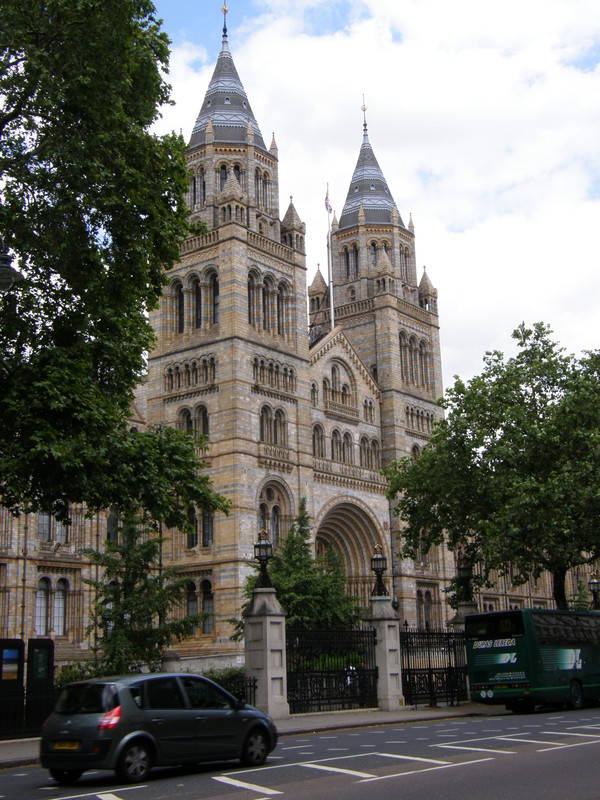
Not far along Cromwell Road from the Tube lies the striking building of the Natural History Museum, its terracotta façade looking for all the world like a massive Victorian layer cake. Opened in 1881, over the road from the Victoria and Albert Museum (which itself was founded in 1852), the Natural History Museum houses some 70 million items, including a famous cast of a Diplodocus skeleton that sits in the central hall of the Waterhouse building, just beneath the main towers. It's a staple of school visits, and I can still remember visiting the dinosaurs for the first time; it's not something you forget in a hurry.
South Kensington station is just down Exhibition Road from the museums, and you could say the station extends along half the road, as there's a pedestrian walkway under Exhibition Road that serves all three museums (the Natural History, Victoria and Albert, and Science Museums). The station itself is hidden behind busy traffic, and still bears iron latticework proclaiming this to be part of the 'Metropolitan and District Railways', which was the case when it opened in 1868 as the western terminus of the original section of the District line, connecting South Kensington to Westminster. Around the back of the station, to the southeast, is a disused Piccadilly line building (from when it was still known as the Great Northern, Piccadilly & Brompton Railway) that sports the instantly recognisable ox-blood red glazed terracotta tiling of the GNP&BR's other stations. This used to provide access to the deep-level Piccadilly line platforms, but was dropped when escalators replaced the lifts.
South Kensington to Sloane Square
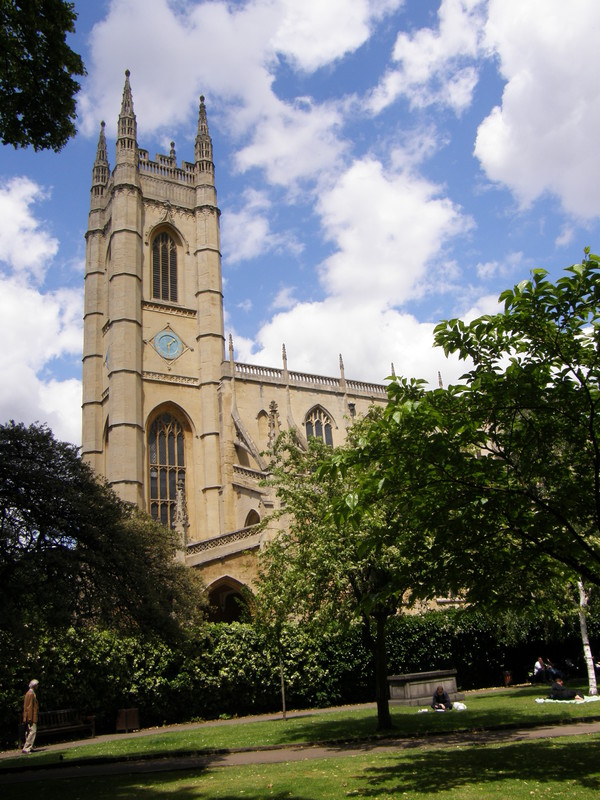
I chose a fairly roundabout route to Sloane Square, because the area to the south of Kensington – Chelsea – is lovely, and this is the only opportunity on my tubewalk to take in some of the great sights of this part of town. Heading south towards the river, I crossed Fulham Road before taking a break for lunch in the pretty little garden next to the impressive St Luke's Church on Sydney Street. Built in Bath stone to resemble King's College Chapel in Cambridge, it has a grand neo-Gothic style, and dates from 1824, which roughly translates into a very grand-looking church indeed.
Next up is a short section along the King's Road, one of the most fashionable shopping streets in the capital, and then it's a right turn down Flood Street, past an antiques centre, a pub, some impressive apartment blocks, and into the stunning mansion blocks of Cheyne Walk. Mick Jagger and Marianne Faithful used to live at number 48, just the other side of Albert Bridge, and they're not alone: other famous Cheyne Walk residents include the landscape painter JMW Turner (who died in 1851 at number 119), Bram Stoker (who lived at number 10), the American artist James Whistler (number 96), Keith Richards (number 3), and Ian Fleming (who rented a flat here while working on his first James Bond novel, Casino Royale). That's not bad for one road, really.
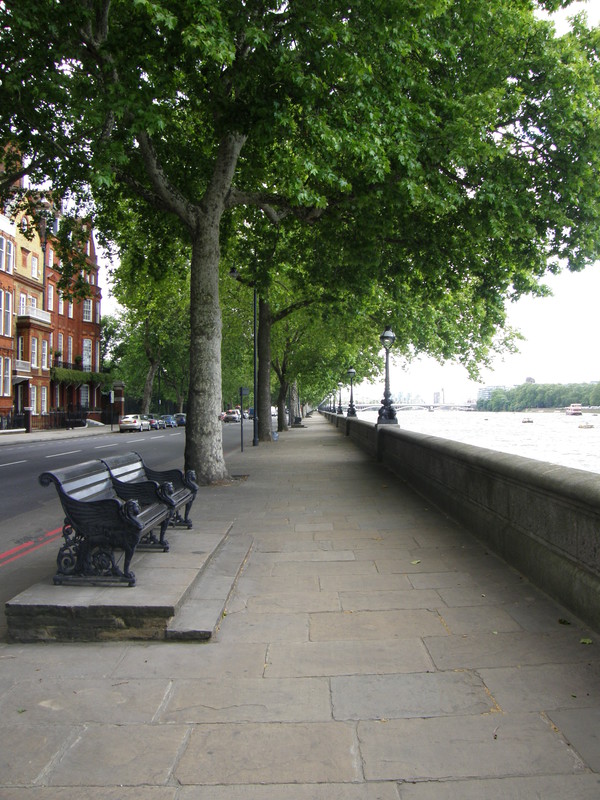
Heading east along the river, with Battersea Park on the opposite bank and Battersea Power Station in the distance, I walked past the Chelsea Physic Garden and Tite Street (where Oscar Wilde lived, at number 34), and to the Bull Ring Gate that leads into the gardens of the Chelsea Royal Hospital. This impressive building, which is home to the Chelsea Pensioners, probably looks better when the lawn isn't being re-seeded, but it's still a glorious building. Designed by Sir Christopher Wren and completed in 1692, it was founded in 1682 by Charles II as a home for the 'succour and relief of veterans broken by age and war,' and is still going strong.
It's an enjoyable walk past yet more intricate terraces to Sloane Square, where Sloane Square station hides almost apologetically in a corner of this traffic hotspot. Architecturally the outside isn't that interesting, but inside there's real engineering at work, for when the Metropolitan District Railway built Sloane Square station in 1868, they had to divert the River Westbourne, which runs through Hyde Park as the Serpentine, and which was once crossed by the Knight's Bridge that gives that suburb its name; above the platform, you can still see the large iron pipe that carries the river safely down to the Thames.
Sloane Square to Victoria

This is a hugely expensive part of town, and the walk from Sloane Square to Victoria wafts across one of the most exclusive addresses in town, that of Belgravia. Groaning under the weight of foreign embassies and old money, it's a wonderful place to walk through (well, unless you're a communist, in which case it must be awful). Everywhere you look there are amazing white stucco terraces gleaming off into the distance, and the whole area is relatively unchanged from when it was developed in the 1820s by the 2nd Marquess of Westminster, Richard Grosvenor. Money still talks round here, and Belgravia is one of the most expensive areas in the world, which possibly explains why you can find Margaret Thatcher (who lives in Chester Square), Roman Abramovich, Joan Collins and Nigella Lawson here.
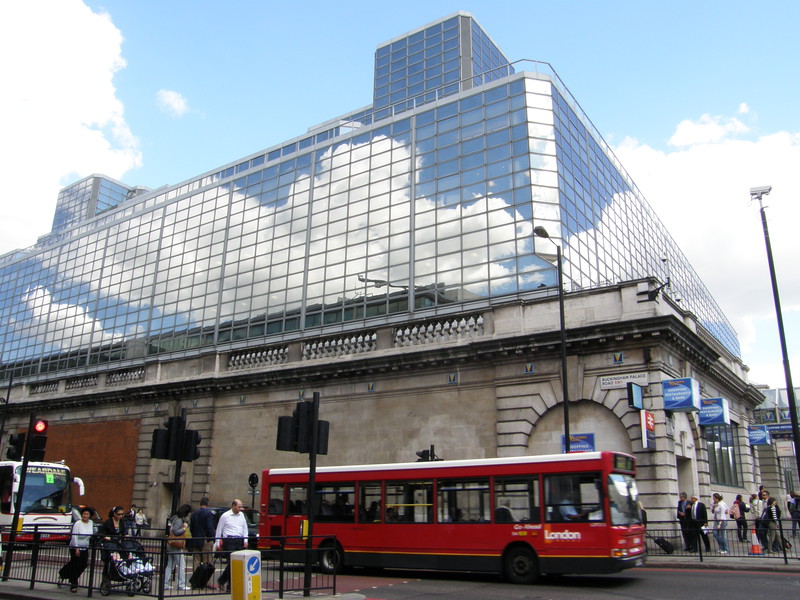
Arriving at busy Buckingham Palace Road is a bit of a shock, the mood switching from historic to ultra-modern with the glass-topped Victoria Place Shopping Centre reflecting the clouds and the glass-fronted London Googleplex, home of Google in the UK, gleaming in the sun. And just around the corner, on the south side of a busy bus stop, is Victoria station, its impressive frontage and huge clock all but hidden by the metal canopy that covers the entrance. The Tube station is buried beneath the bus stop, and gets horribly busy at rush hour, so much so that staff often close the access stairway when the platforms get too full. I used to commute this way when I lived in Balham, and ended up walking from here to where I worked in the V&A, rather than take the Tube. Perhaps that's where the inspiration for this tubewalk came from, after all...